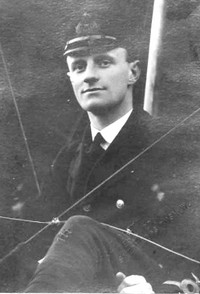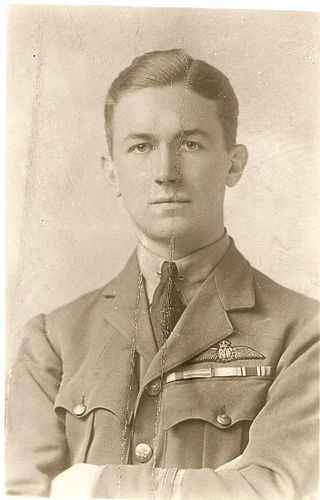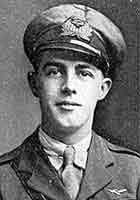Related Research Articles
Robert Alexander Little,, a World War I fighter pilot, is generally regarded as the most successful Australian flying ace, with an official tally of forty-seven victories. Born in Victoria, he travelled to England in 1915 and learned to fly at his own expense before joining the Royal Naval Air Service (RNAS). Posted to the Western Front in June 1916, he flew Sopwith Pups, Triplanes and Camels with No. 8 Squadron RNAS, achieving thirty-eight victories within a year and earning the Distinguished Service Order and Bar, the Distinguished Service Cross and Bar, and the French Croix de guerre. Rested in July 1917, he volunteered to return to the front in March 1918 and scored a further nine victories with No. 3 Squadron RNAS before he was killed in action on the night of 27 May, aged twenty-two.
Richard Pearman Minifie, was an Australian fighter pilot and flying ace of the First World War. Born in Victoria, he attended Melbourne Church of England Grammar School. Travelling to the United Kingdom, he enlisted in the Royal Naval Air Service in June 1916. Accepted for flight training, he completed his instruction in December and joined No. 1 (Naval) Squadron RNAS on the Western Front in January 1917, flying Sopwith Triplanes. He went on to score seventeen aerial victories on this type of machine throughout the year, becoming both the youngest Australian flying ace of the First World War and No. 1 (Naval) Squadron's highest-scoring ace on the Triplane. The unit re-equipped with the Sopwith Camel late in 1917, with Minifie going on to achieve a further four victories on the aircraft, raising his final tally to a score of twenty-one aircraft shot down.
Captain William Lancelot Jordan DSC & Bar, DFC was a South African World War I flying ace credited with 39 victories.
Captain William Melville Alexander was a Canadian First World War flying ace, officially credited with 22 aerial victories.
Leonard Henry Rochford, was a British flying ace of the First World War, credited with 29 aerial victories. He returned to military service in the Royal Air Force during the Second World War.
Wing Commander Robert John Orton Compston DSC & 2 Bars DFC was an English fighter pilot credited with 25 victories during World War I. He was one of only seven airman in this war who won three awards of the Distinguished Service Cross.
Flight Lieutenant Cyril Burfield Ridley was a British World War I flying ace, who served in the Royal Naval Air Service and the Royal Air Force, before being killed in a flying accident in 1920.
Group Captain Anthony Rex Arnold was a British World War I flying ace credited with five aerial victories.
Captain Rowan Heywood Daly was a British flying ace credited with three aerial victories during World War I, and an additional four victories in Russia during 1919.

Captain Howard John Thomas Saint was a Welsh First World War flying ace credited with seven aerial victories. He became the chief test pilot for the Gloster Aircraft Company in the 1930s.

Captain Albert James Enstone was a British World War I flying ace. Various sources credit him with differing air victory scores. In one text, he is credited with 13 confirmed aerial victories and driving down 11 other German aircraft, including three Gotha bombers. Another source claims 15 confirmed aerial victories; ten were destroyed, and five were driven down out of control. He is known to have attacked two Gotha bombers. Regardless of his actual victory totals, records show that Enstone served his country valiantly.
Captain Harold Thomas Mellings was a British World War I flying ace credited with 15 aerial victories.
Captain John Ellis Langford Hunter was a British World War I flying ace credited with 13 confirmed aerial victories.

Flight Sub-Lieutenant Harold Day was a Welsh World War I flying ace credited with 11 confirmed aerial victories.

Captain Reginald Rhys Soar was a British flying ace during World War I. He was credited with 12 official aerial victories won while serving in the Dardanelles and along the English Channel.
Major Thomas Francis Netterville Gerrard was a British World War I flying ace credited with ten aerial victories. He died following a post-war equestrian accident.
Flight Lieutenant Charles John Sims, was an English World War I flying ace credited with nine aerial victories. His most notable victory saw him shoot down an enemy aircraft that crashed into another, giving Sims a double win. However, his Distinguished Flying Cross was awarded for his courage in ground attack missions.
Air Commodore Herbert Victor Rowley was a British air officer of the Royal Air Force. He was a World War I flying ace, credited with nine aerial victories while serving in the Royal Naval Air Service, but became a member of the Royal Air Force when the RNAS was consolidated into it. Rowley remained in the RAF post-war, serving through World War II, until retiring in 1944.
Captain Ronald Roscoe Thornely was an English World War I flying ace. He was credited with nine aerial victories while flying for the Royal Naval Air Service.
Captain George Goodman Simpson was an Australian-born flying ace credited with eight confirmed victories while flying for the Royal Naval Air Service during World War I. He would serve his country again during World War II.
References
- Notes
- 1 2 3 4 5 6 "Desmond Fitzgerald Fitzgibbon". The Aerodrome. 2014. Retrieved 10 December 2014.
- ↑ Fox-Davies, Arthur Charles, ed. (1929). Armorial Families : A Directory of Gentlemen of Coat-Armour. Vol. 1 (7th ed.). London: Hurst & Blackett. p. 679. Retrieved 10 December 2014.
- ↑ Franks (2004), p.78.
- ↑ "No. 29786". The London Gazette (Supplement). 17 October 1916. p. 9953.
- ↑ Rickard, J. (3 October 2008). "Sopwith 9700 Type 1½ Strutter bomber". History of War. Retrieved 10 December 2014.
- ↑ Peason, Bob (2014). "More Than Would Be Reasonably Anticipated: The Story of No. 3 Wing". Over The Front. Retrieved 10 December 2014.
- 1 2 Franks (2004), p.7.
- 1 2 Shores et.al. (1990), pp.156.
- ↑ "Royal Naval Air Service". Flight . IX (453): 899. 30 August 1917. Retrieved 10 December 2014.
- ↑ "No. 30324". The London Gazette. 5 October 1917. p. 10297.
- ↑ "No. 30363". The London Gazette (Supplement). 30 October 1917. p. 11321.
- ↑ "No. 31157". The London Gazette. 31 January 1919. p. 1537.
- ↑ "No. 31380". The London Gazette. 3 June 1919. p. 7071.
- ↑ "No. 32250". The London Gazette. 8 March 1921. p. 1899.
- ↑ "No. 33474". The London Gazette. 5 March 1929. p. 1578.
- ↑ "Nuwara Eliya Birth/Baptism Records Ceylon (Sri Lanka) (F)". The Kabristan Archives. 2014. Retrieved 10 December 2014.
- ↑ "No. 34727". The London Gazette. 7 November 1939. p. 7503.
- ↑ "No. 35503". The London Gazette. 27 March 1942. p. 1392.
- ↑ "No. 36866". The London Gazette (Supplement). 29 December 1944. p. 64.
- Bibliography
- Franks, Norman (2004). Sopwith Triplane Aces of World War I. London, UK: Osprey Publishing. ISBN 978-1841767284.
- Shores, Christopher F.; Franks, Norman & Guest, Russell F. (1990). Above the Trenches: a Complete Record of the Fighter Aces and Units of the British Empire Air Forces 1915-1920. London, UK: Grub Street. ISBN 978-0-948817-19-9.